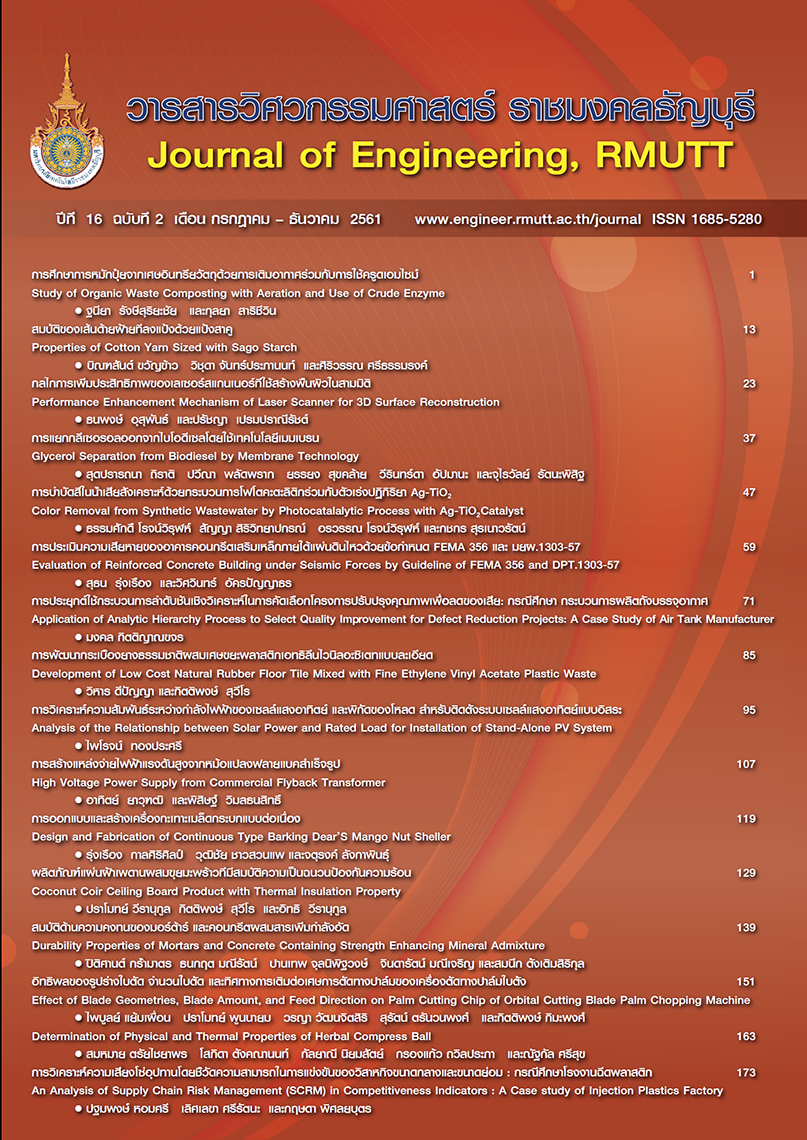Study of Organic Waste Composting with Aeration and Use of Crude Enzyme
Main Article Content
Abstract
The study of organic waste composting with aeration and by adding crude enzyme powder from Trichoderma reesei and mixed-type between Trichoderma reesei and Saccharomyces cerevisiae was conducted to compare the characteristics of compost using 24 hours operated and periodically every 6 hours operated aerator combined with the different amounts of crude enzyme. The results showed that the temperature during the experimental process is in the range of 28-41 °C which is usually called mesophilic phase. The moisture content ranged between 47-90% of which the higher humidity occurred at the beginning caused the slow process of fermentation. At the end of the experiment, pH was found in the range of 8-9 and phosphorus contained in the compost was in the range between 0.66 to 1.05%. The characteristics of the fertilizer nutrients N, P, K, in almost compost crates met the requirements nutrients for standard compost. Carbon to Nitrogen ratio (C/N ratio) of crate no.1 (24 hrs. operated aerator with 180g Trichoderma reesei added) is the only crate that met the standard composting with C/N of 20:1. The C/N ratio of crates no.2-8 were approximately 30:1. By considering the aeration patterns, the 24 hrs. operated aerator was considered the best condition for this study and a crate no.1 (24 hrs. operated aerator with 180g Trichoderma reesei added) demonstrated the best results to satisfy the standard compost.
Article Details
The manuscript, information, content, picture and so forth which were published on Frontiers in engineering innovation research has been a copyright of this journal only. There is not allow anyone or any organize to duplicate all content or some document for unethical publication.
References
Pollution Control Department. Action Plan "Thailand Free of Garbage" according to the "public" guidelines for a year (2016-2017) [Internet]. 2016 [cited 2017 Jan 1]: [about 1 p.]. Available from: http://infofile.pcd.go.th/waste/
ThaiPlans%20without%20Waste.pdf?CFID=2929130&CFTOKEN=49324635 (in Thai)
Srisatit T. Municipal Solid Waste Management Engineering. 1st ed. Bangkok: The Engineering Institute of Thailand under H.M. The King’s Patronage; 2015. (in Thai)
Siwarasak P, Yaowalak T, Jutarat N, Nirun J, Tom M. Crude Enzyme Powder Utilization for Ethanol Fermentation from Pineapple Skins. 7th Conference On Energy Network of Thailand. 2011 May 3-5:13-8. (in Thai)
Siwarasak P, Pajantagate P, Prasertlertart K. Use of Trichoderma reesei RT-P1 Crude Enzyme Power for Ethanol Fermentation of Sweet Sorghum Fresh Stalks. Bioresource Technology. 2012;107:200-4.
Zhang L, Sun X. Effects of Earthworm Casts and Zeolite on the Two-Stage Composting of Green Waste. Waste Management. 2015;39: 119-29.
Karnchanawang S, Suriyanon N. 2011. Household Organic Waste Composting using Bins with different types of passive aeration. Resource, Conservation and Recycling. 2011;55: 548-53.
Saricheewin K, Rangseesuriyachai T. Composting of Organic Waste Using Aeration Tank. Journal of Engineering, RMUTT. 2016;14(1):25-34. (in Thai)
Department of Agriculture. Manual of Organic Fertilizer Analysis. 1st ed. Bangkok: Department of Agriculture; 2008. (in Thai)
Manu, M.K., Kumar, R., Garg, A.. 2017. Performance Assessment of Improved Composting System for Food Waste with Varying Aeration and Use of Microbial Inoculum. Bioresource Technology. 2017;234: 167-77.
Osotspa Y, Wongmaneeroj A, Hongprayun C.Fertilizer for Sustainable Agriculture. 2nd ed. Bangkok: Kasetsart University Press; 2011. (in Thai)
Gaur A.C., Sadasivan K.U., Mathur R.S., Magu S.P. Role of Mesophilic Fungi in Composting. Agricultural Waste. 1982;4:453-60.
Martins O., Dewes T. Loss of nitrogenous compounds during composting of animal wastes. Bioresource Technology. 1992;42: 103-11.
Land Developement Department. Operational Guide: Plant, Fertilizer and Soil Analysis Processes [Internet]. 2010 [cited 2017 Sep 16]: [about 1 p.]. Available from: http://www.ldd.go.th/PMQA/ 2553/Manual/OSD-07.pdf (in Thai)
Chanchampee P. Thermophilic Composting of Food Waste and Farm Residue by Rotary Drum [dissertation]. Chiangmai: Chiangmai University; 1998. (in Thai)
Sánchez C. Lignocellulosic Residues: Biodegradation and Bioconversion by Fungi. Biotechnology Advance. 2009; 27:185-94.
Mohammad N., Zahaagir Alam Md., Nassereldeen A.K., Amimul, A. Effective Composting of Oil Palm Industrial Waste by Filamentous: A review. Resources Conservation and Recycling. 2012;58:69-78.
Zhisheng Y, Hongxun, Z. Ethanol Fermentation of Acid-Hydrolyzed Cellulosic Pyrolysate with Saccharomyces cerevisiae. Bioresource Technology. 2004;93: 199-204.
Rui G., Guoxue L., Tao J., and et al. Effect of aeration rate, C/N ratio and moisture content on the stability and maturity of compost. Bioresource Technology. 2012;112:171-78.


